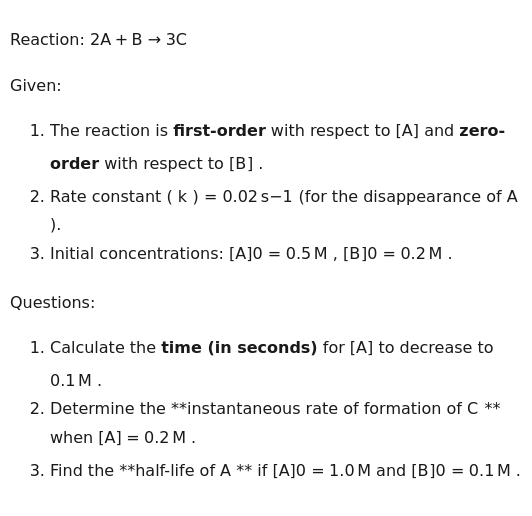Question
Question: Reaction: \[ 2A + B \rightarrow 3C \] Given: 1. The reaction is **first-order** with respect to \(...
Reaction: 2A+B→3C
Given:
- The reaction is first-order with respect to [A] and zero-order with respect to [B].
- Rate constant (k) = 0.02s−1 (for the disappearance of A).
- Initial concentrations: [A]0=0.5M, [B]0=0.2M.
Questions:
- Calculate the time (in seconds) for [A] to decrease to 0.1M.
- Determine the instantaneous rate of formation of C when [A]=0.2M.
- Find the half-life of A if [A]0=1.0M and [B]0=0.1M.

- Time for [A] to decrease to 0.1M: 80.47s
- Instantaneous rate of formation of C: 0.006M s−1
- Half-life of A: Not achievable
Solution
The problem involves applying the concepts of chemical kinetics, including rate laws, integrated rate laws, stoichiometry, and limiting reactants.
Given Information:
- Reaction: 2A+B→3C
- Rate Law: First-order with respect to [A] and zero-order with respect to [B]. This means the rate law is Rate=k[A]. For the disappearance of A, −dtd[A]=k[A].
- Rate constant (k): 0.02s−1 (for the disappearance of A). The unit s−1 confirms it's a first-order reaction.
- Initial concentrations: [A]0=0.5M, [B]0=0.2M.
1. Calculate the time (in seconds) for [A] to decrease to 0.1M.
Since the reaction is first-order with respect to A, the integrated rate law is: ln([A]0[A]t)=−kt We are given:
- [A]0=0.5M
- [A]t=0.1M
- k=0.02s−1
Substitute the values into the equation: ln(0.5M0.1M)=−(0.02s−1)t ln(0.2)=−0.02t −1.6094=−0.02t t=0.021.6094 t=80.47s
2. Determine the instantaneous rate of formation of C when [A]=0.2M.
First, calculate the instantaneous rate of disappearance of A using the rate law: −dtd[A]=k[A] When [A]=0.2M and k=0.02s−1: −dtd[A]=(0.02s−1)(0.2M) −dtd[A]=0.004M s−1
Next, relate the rate of disappearance of A to the rate of formation of C using the stoichiometry of the reaction 2A+B→3C. The general rate expression based on stoichiometry is: Rate=−21dtd[A]=+31dtd[C] We need to find +dtd[C]: dtd[C]=−23dtd[A] Substitute the calculated rate of disappearance of A (which is a positive value): dtd[C]=23×(0.004M s−1) dtd[C]=1.5×0.004M s−1 dtd[C]=0.006M s−1
3. Find the half-life of A if [A]0=1.0M and [B]0=0.1M.
For a first-order reaction, the half-life (t1/2) is given by: t1/2=kln(2) Given k=0.02s−1: t1/2=0.02s−10.693 t1/2=34.65s
However, we must check if the reaction can proceed long enough for A to reach its half-life concentration given the initial amounts of reactants. For [A]0=1.0M, the half-life means [A] decreases to [A]0/2=1.0M/2=0.5M. The amount of A that needs to be consumed is Δ[A]=1.0M−0.5M=0.5M.
From the stoichiometry 2A+B→3C, 2 moles of A react with 1 mole of B. To consume 0.5M of A, the amount of B required is: Required Δ[B]=21×Δ[A]=21×0.5M=0.25M The initial concentration of B available is [B]0=0.1M. Since the required amount of B (0.25M) is greater than the available amount of B (0.1M), B is the limiting reactant. The reaction will stop when all of B is consumed.
When 0.1M of B is consumed, the amount of A consumed will be: Δ[A]=2×Δ[B]=2×0.1M=0.2M The concentration of A remaining at this point will be: [A]final=[A]0−Δ[A]=1.0M−0.2M=0.8M Since the final concentration of A (0.8M) is greater than its half-life concentration (0.5M), the half-life of A is not achievable under these conditions because B runs out first.
Explanation of the solution:
- Time for [A] to decrease: Use the integrated rate law for a first-order reaction: t=k1ln([A]t[A]0). Substitute the given initial and final concentrations of A and the rate constant to find the time.
- Instantaneous rate of formation of C: First, calculate the instantaneous rate of disappearance of A using the given rate law −dtd[A]=k[A]. Then, use the stoichiometric relationship from the balanced chemical equation −21dtd[A]=+31dtd[C] to find the rate of formation of C.
- Half-life of A: Calculate the theoretical half-life for a first-order reaction using t1/2=kln(2). Then, check if the reaction can actually proceed to the half-life concentration of A by determining if the limiting reactant (B) runs out before A reaches half its initial concentration. If B is exhausted first, A's half-life is not achievable.
